1997 GMC SIERRA check oil
[x] Cancel search: check oilPage 280 of 436

Some gasolines that are not reformulated for low
emissions contain
an octane-enhancing additive called
methylcyclopentadlenyl manganese tricarbonyl
(MMT);
ask your service station operator whether or not his fuel
contains
"T. General Motors does not recommend the
use of such gasolines.
If fuels containing MMT are used,
spark plug life may
be reduced and your emission control
system performance may
be affected. The malfunction
indicator lamp on your instrument panel may
turn on. If this
occurs, return to your authorized GM dealer for service.
To provide cleaner air, all gasolines in the United States
are now required to contain additives that
will help prevent
deposits from forming
in your engine and fuel system,
allowing your emission control system to function
properly. Therefore, you should not have to add anything
to the fuel. In addition, gasolines containing oxygenates,
such
as ethers and ethanol, and reformulated gasolines
may
be available in your area to help clean the air. General
Motors recommends that you use these gasolines
if they
comply
with the specifications described earlier.
NOTICE:
Your vehicle was not designed for fuel that
contains methanol. Don't use it. It can corrode
NOTICE: (Continued)
I NOTICE: (Continued) I
metal parts in your fuel system and also damage
plastic and rubber parts. That damage wouldn't
be covered under your warranty.
Fuels in Foreign Countries -- Gasoline
Engines
If you plan on driving in another country outside the
United States or Canada, the proper fuel may be hard
to find. Never use leaded gasoline or
any other fuel not
recommended
in the previous text on fuel. Costly repairs
caused
by use of improper fuel wouldn't be covered by
your warranty.
To check on fuel availability, ask an auto club, or
contact
a major oil company that does business in the
country where you'll be driving.
You can also write us
at the following address for
advice. Just tell
us where you're going and give your
Vehicle Identification Number (VIN).
General Motors International Product Center 1908 Colonel Sam Drive
Oshawa, Ontario
L 1 H 8P7
6-4
ProCarManuals.com
Page 284 of 436
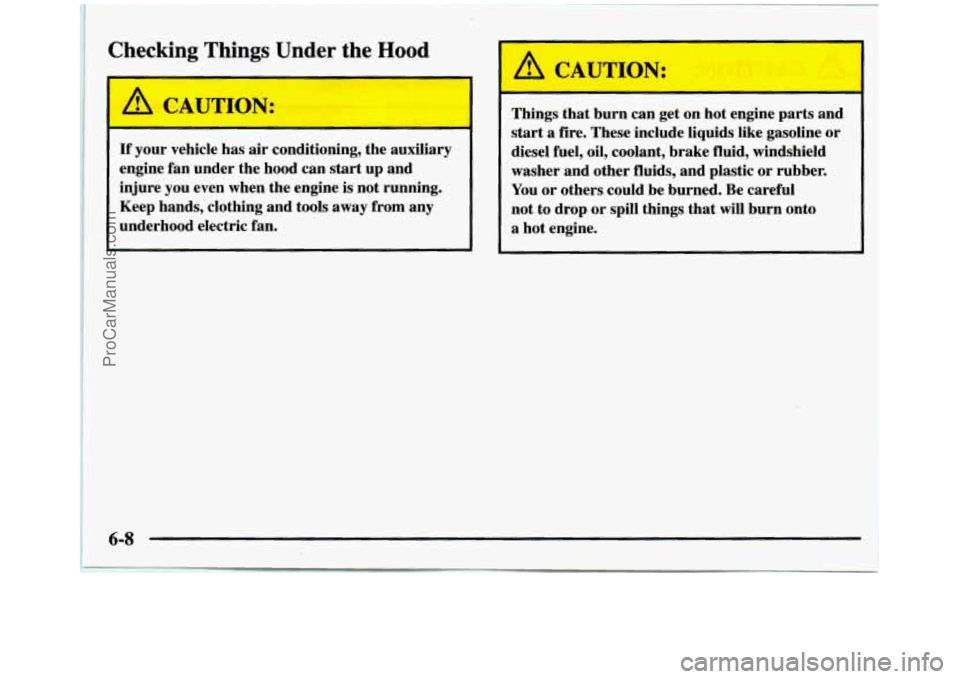
Checking Things Under the Hood
I A CAUTION:
If your vehicle has air conditioning, the auxiliary
engine fan under the hood can
start up and
injure you even when the engine
is not running.
Keep hands, clothing and tools away from any
underhood electric
fan.
t -4
Things that burn can get on hot engine parts and
start a fire. These include liquids like gasoline or
diesel fuel, oil, coolant, brake fluid, windshield
washer and other fluids, and plastic or rubber. You or others could be burned. Be careful
not to drop or spill things that will burn onto
a hot engine.
ProCarManuals.com
Page 291 of 436

Engine Oil (Gasoline Engine)
If your vehicle has a diesel engine, see “Engine Oil (Diesel Engine)” in the Diesel Engine Supplement.
It’s a good idea to check your engine oil every time you
get fuel. In order to get an accurate reading, the oil must
be warm and the vehicle must be on level ground.
The engine oil dipstick has
a yellow ring handle and is
located on the passenger’s side
of the engine.
Turn
off the engine and give the oil a few minutes to
drain back into the oil pan.
If you don’t, the oil dipstick
might not show the actual level.
Checking Engine Oil
Pull out the dipstick and clean it with a paper towel or
cloth, then push it back in all the way. Remove it again,
keeping the tip down, and check the level.
When to Add Oil
If the oil is at or below the ADD mark, then you’ll need
to add at least one
quart of oil. But you must use the
right kind. This part explains what kind of oil to use.
For
crankcase capacity, see “Capacities and Specifications”
in the Index.
6-15
ProCarManuals.com
Page 297 of 436
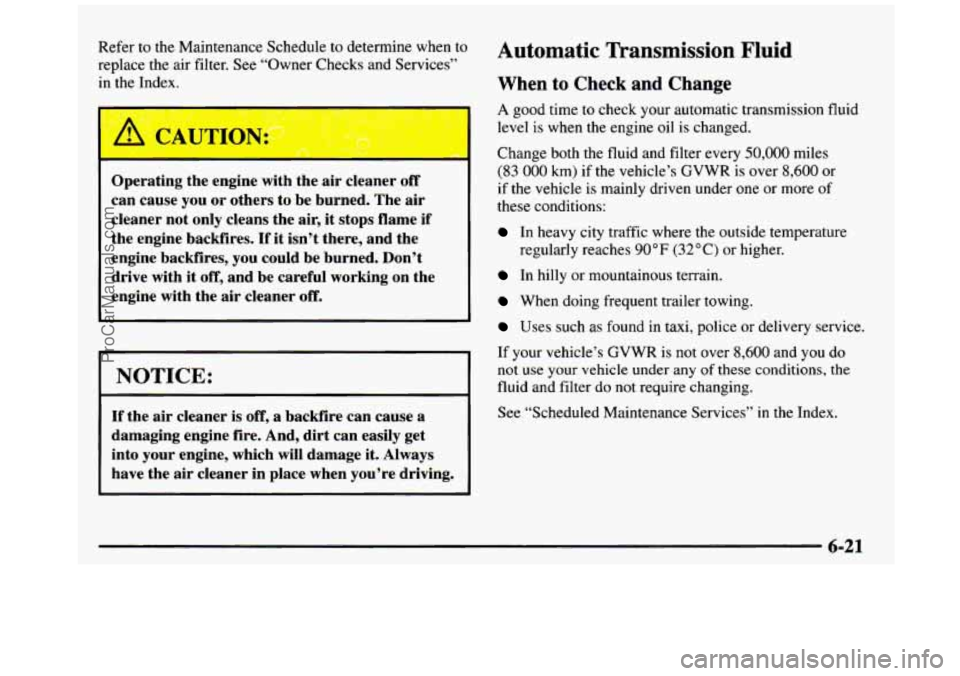
Refer to the Maintenance Schedule to determine when to
replace the air filter. See “Owner Checks and Services”
in
the Index.
Operating the engine with the
air cleaner off
can cause you OF others to be burned. The air
cleaner not only cleans the air,
it stops flame if
the engine backfires.
If it isn’t there, and the
engine backfires, you could be burned. Don’t
drive with it
off, and be careful working on the
engine with the air cleaner
off.
I NOTICE:
If the air cleaner is off, a backfire can cause a
damaging engine fire. And, dirt can easily get
into your engine, which will damage it. Always
have the air cleaner in place when you’re driving.
Automatic Transmission Fluid
When to Check and Change
A good time to check your automatic transmission fluid
level is
when the engine oil is changed.
Change both the fluid and filter every
50,000 miles
(83
000 km) if the vehicle’s CVWR is over 8,600 or
if the vehicle is mainly driven under one or more
of
these conditions:
In heavy city traffic where the outside temperature
regularly reaches
90°F (32°C) or higher.
In hilly or mountainous terrain.
When doing frequent trailer towing.
Uses such as found in taxi, police or delivery service.
If your vehicle’s GVWR is not over
8,600 and you do
not use your vehicle under any
of these conditions, the
fluid and filter do
not require changing.
See “Scheduled Maintenance Services’’
in the Index.
ProCarManuals.com
Page 301 of 436
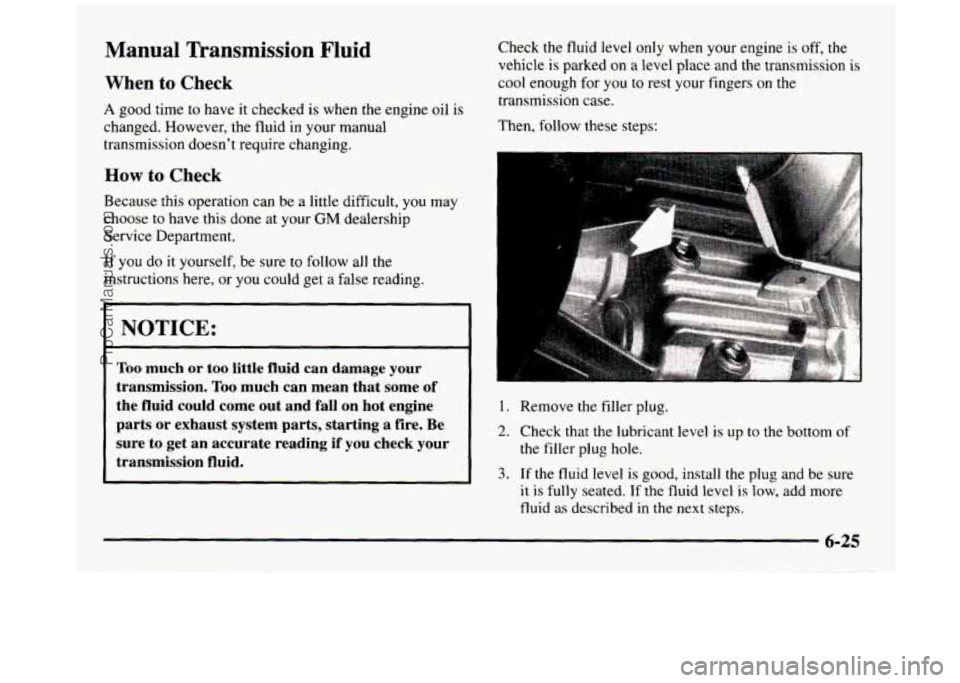
Manual Transmission Fluid
When to Check
A good time to have it checked is when the engine oil is
changed. However, the fluid
in your manual
transmission doesn’t require changing.
How to Check
Because this operation can be a little difficult, you may
choose to have this done at your
GM dealership
Service Department.
If you do it yourself, be sure to follow all the
instructions here, or you could get a false reading.
NOTICE:
Too much or too little fluid can damage your
transmission.
Too much can mean that some of
the fluid could come out and
fall on hot engine
parts or exhaust system parts, starting
a fire. Be
sure to get an accurate reading if
you check your
transmission fluid.
Check the fluid level only when your engine is off, the
vehicle is parked on
a level place and the transmission is
cool enough for you to rest your fingers on the
transmission case.
Then, follow these steps:
1. Remove the filler plug.
2. Check that the lubricant level is up to the bottom of
3. If the fluid level is good, install the plug and be sure
the
filler plug hole.
it
is fully seated. If the fluid level is low, add more
fluid as described
in the next steps.
ProCarManuals.com
Page 306 of 436
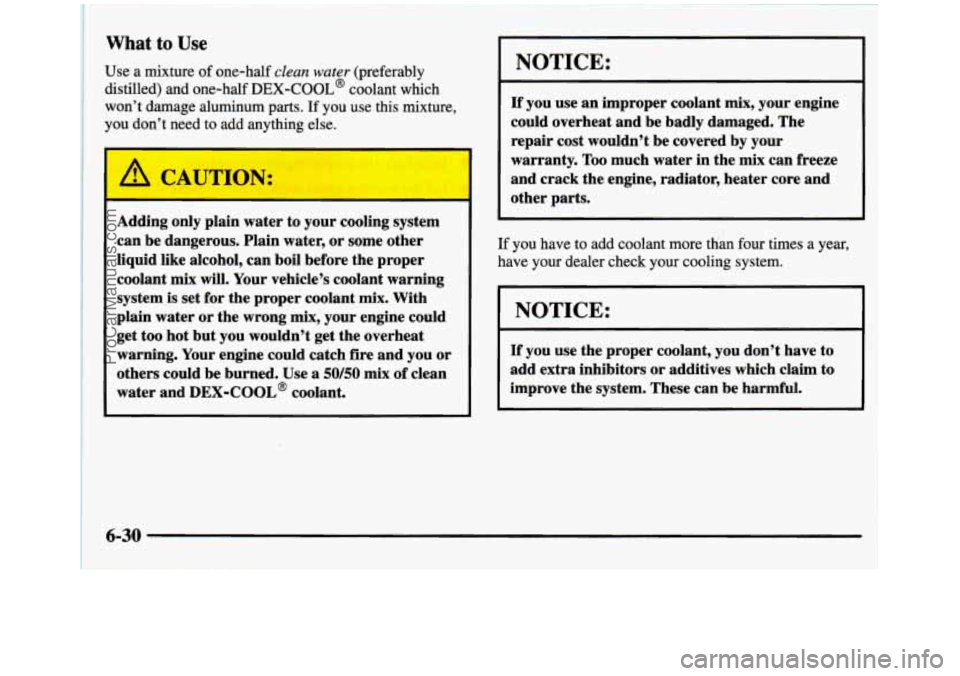
What to Use
Use a mixture of one-half clean water (preferably
distilled) and one-half
DEX-COOL’ coolant which
won’t damage aluminum parts.
If you use this mixture,
you don’t need to add anything else.
A CAUTION:
Adding only plain water to your cooling system
can
be dangerous. Plain water, or some other
liquid like alcohol, can boil before the proper
coolant
mix will. Your vehicle’s coolant warning
system is set for the proper coolant
mix. With
plain water or the wrong
mix, your engine could
get too hot but you wouldn’t get the overheat
warning. Your engine could catch fire and you or
others could be burned. Use a
50/50 mix of clean
water and
DEX-COOL@ coolant.
NOTICE:
If you use an improper coolant mix, your engine
could overheat and be badly damaged. The
repair cost wouldn’t be covered
by your
warranty. Too much water in the mix can freeze
and crack the engine, radiator, heater core and
other parts.
If you have to add coolant more than four times a year,
have your dealer check your cooling system.
NOTICE:
If you use the proper coolant, you don’t have to
add extra inhibitors or additives which claim to
improve the system. These can be harmful.
6-30
ProCarManuals.com
Page 354 of 436
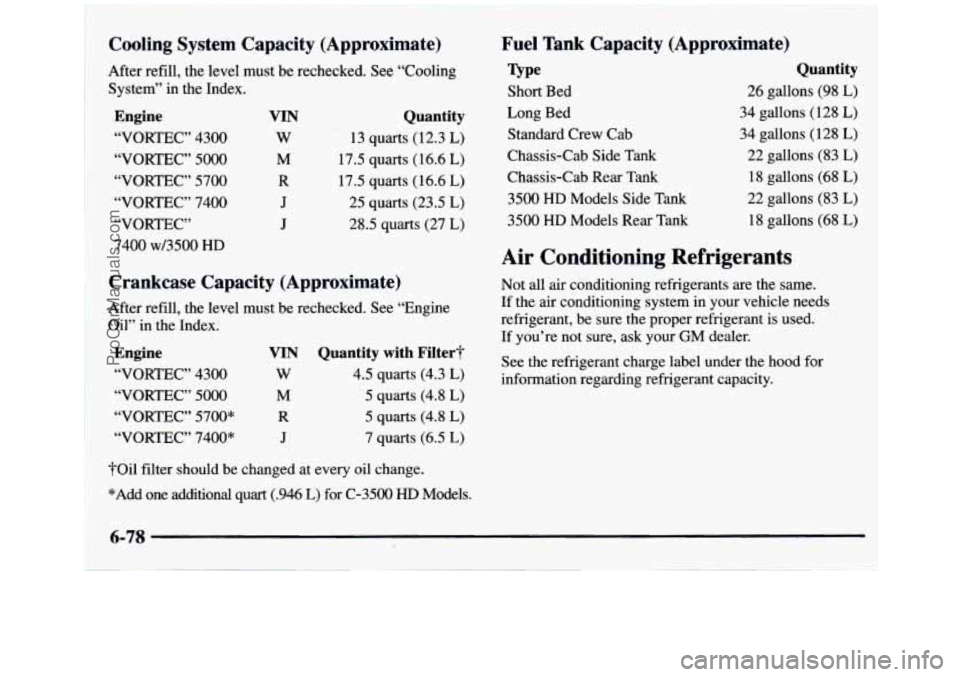
Fuel Tank Capacity (Approximate)
Type
Short Bed
Long Bed Standard Crew Cab
Chassis-Cab Side Tank
Chassis-Cab Rear Tank 3500
HD Models Side Tank
3500
HD Models Rear Tank
Cooling System Capacity (Approximate)
After refill, the level must be rechecked. See “Cooling
System” in the Index.
Engine
“VORTEC” 4300
“VORTEC”
5000
“VORTEC” 5700
“VORTEC” 7400
“VORTEC”
7400
w/3500 HD
VIN
W
M
R
J
J
Quantity
13 quarts (12.3 L)
17.5 quarts (16.6 L)
17.5 quarts (16.6 L)
25 quarts (23.5 L)
28.5 quarts (27 L)
Crankcase Capacity (Approximate)
After refill, the level must be rechecked. See “Engine
Oil” in the Index.
Engine
“VORTEC” 4300
“VORTEC”
5000
“VORTEC” 5700”
“VORTEC” 7400*
VIN
W
M
R
J
Quantity with Filter?
5 quarts (4.8 L)
5 quarts (4.8 L)
7 quarts (6.5 L)
4.5 quarts (4.3
L)
?Oil
filter should be changed at every oil change.
*Add one additional quart (.946
L) for C-3500 HD Models.
Quantity
26 gallons (98 L)
34 gallons (128 L)
34 gallons (128 L)
22 gallons (83 L)
18 gallons (68 L)
22 gallons (83 L)
18 gallons (68 L)
Air Conditioning Refrigerants
Not all air conditioning refrigerants are the same.
If the
air conditioning system in your vehicle needs
refrigerant, be sure the proper refrigerant
is used.
If you’re not sure, ask your GM dealer.
See the refrigerant charge label under the hood for
information regarding refrigerant capacity.
6-78
ProCarManuals.com
Page 362 of 436
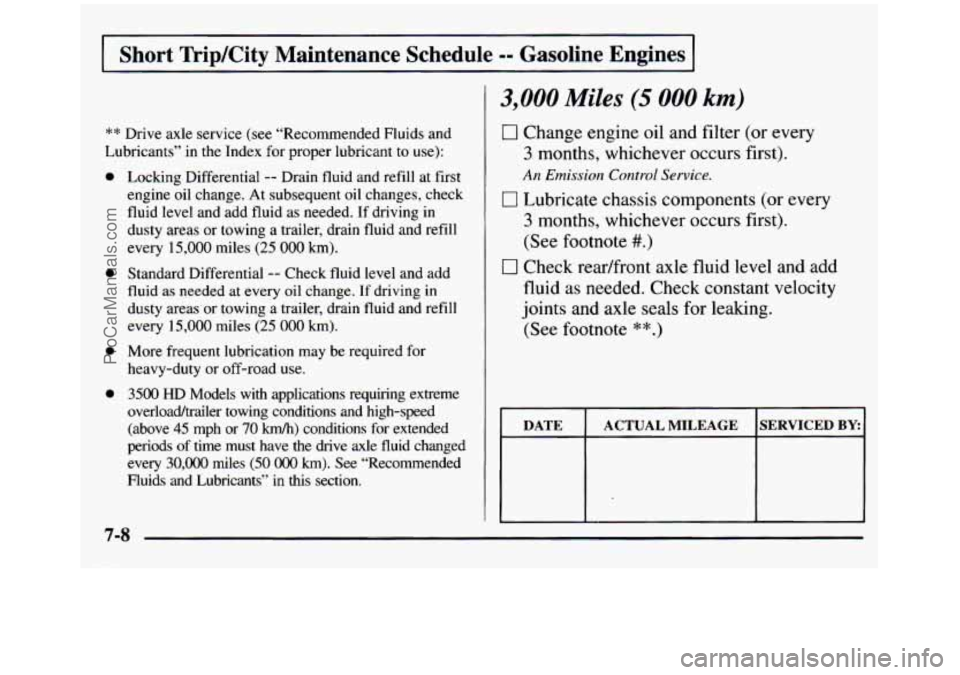
Short TripKity Maintenance Schedule -- Gasoline Engines
** Drive axle service (see “Recommended Fluids and
Lubricants”
in the Index for proper lubricant to use):
0
e
0
0
Locking Differential -- Drain fluid and refill at first
engine oil change. At subsequent oil changes, check
fluid level and add fluid as needed. If driving in
dusty areas
or towing a trailer, drain fluid and refill
every 15,000 miles
(25 000 km).
Standard Differential -- Check fluid level and add
fluid
as needed at every oil change. If driving in
dusty areas or towing a trailer, drain fluid and refill
every
15,000 miles (25 000 km).
More frequent lubrication may be required for
heavy-duty
or off-road use.
3500 HD Models with applications requiring extreme
overloadtrailer towing conditions and high-speed (above
45 mph or 70 km/h) conditions for extended
periods of time must have the drive axle fluid changed every
30,000 miles (50 OOO km). See “Recommended
Fluids and Lubricants” in this section.
3,000 Miles (5 000 km)
0 Change engine oil and filter (or every
3 months, whichever occurs first).
An Emission Control Service.
0 Lubricate chassis components (or every
3 months, whichever occurs first).
(See footnote
#.)
0 Check readfront axle fluid level and add
fluid as needed. Check constant velocity
joints and axle seals for leaking.
(See footnote **.)
DATE ACTUAL MILEAGE SERVICED BY:
ProCarManuals.com